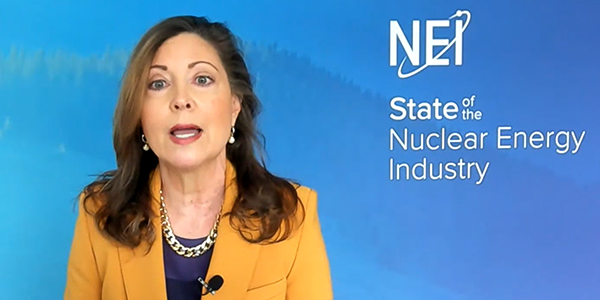Nuclear energy is not only one component but “key” to the world’s carbon-free future, Nuclear Energy Institute CEO Maria Korsnick said in her annual State of the Industry address Tuesday.
The pitch, from the head of the nuclear industry’s main advocacy group, was the strongest statement yet in Korsnick’s yearly speeches that nuclear should play a major role in a net-zero landscape.
In her address last year, Korsnick portrayed the nuclear industry as a good partner with renewables. (See NEI Emphasizes Cooperation with Renewables.)
This year, she sold it as the best-qualified leader.

NEI CEO Maria Korsnick | NEI
“Optimism can be in short supply these days,” Korsnick said. “When we talk about the future, we mostly hear about threats,” including the “threat of a destroyed environment if we can’t reduce carbon emissions. Those threats are real. But I’m here to tell you that they are also opportunities — and that nuclear energy is the key to seizing them. From good-paying jobs and carbon-free electricity to U.S. global leadership, nuclear energy is the source that can make it all work.”
Korsnick said that when she spoke last year, there was widespread consensus that the world needs to decarbonize while meeting growing demand, and that to avoid the worst effects of climate change, carbon emissions from generation would need to be nearly zero by 2050.
“Since then, utilities, state governments and the new Biden administration have made concrete commitments for getting there even sooner, by 2035,” she said. “Fortunately, as we strive to meet those commitments, the U.S. leads the world in producing a proven, carbon-free, scalable source of electricity that enjoys bipartisan support. That source is nuclear energy. And there’s no more serious debate: It’s the key to making our climate commitments work.”
Nuclear plants produce more than half of the carbon-free electricity in the U.S., the most of any resource category, Korsnick said. With 55 plants producing 800 million MWh, nuclear is now the second-largest source of electricity in the U.S., having surpassed coal for the first time ever last year, she said. Nuclear plants have generally operated at more than 90% of capacity, with greater reliability than intermittent renewables, she said.
Advocates of wind and solar often speak of the job-creation benefits of the switch to carbon-free energy. Korsnick said nuclear can also be a source of job creation, often for well paid union members. She cited the Vogtle 3 reactor in Georgia, scheduled to go online later this year, as a good example.
“At its height, the project employed 8,000 people, from electricians to engineers,” she said. “Undeterred by a global pandemic, they’re getting the job done. When completed, the two new Vogtle reactors will produce more carbon-free electricity than all 7,200 wind turbines in the state of California.”
The next generation of nuclear will see new technologies such as small modular reactors and microreactors that can adjust their output, unlike the large baseline reactors of today, and can more easily work in combination with wind and solar, she said.
In addition, she said, a new breed of reactors “can bring clean electricity to hard-to-reach places where traditional reactors just don’t make sense. These communities generally rely on expensive, carbon-emitting sources.”
“From Alaska and Puerto Rico to parts of the developing world, nuclear can be a gamechanger,” Korsnick said.
She noted that NuScale Power received approval from the Nuclear Regulatory Commission last year for its small reactor design. Proponents hope the design will help revive the nation’s nuclear industry, while others remain skeptical given the declining costs of renewables and battery storage. (See NRC OKs NuScale’s Small Modular Reactor Design.)
In Canada, she said, Ontario Power Generation has partnered with Ultra Safe Nuclear to build a micro modular reactor. And the U.S. Department of Energy’s Advanced Reactor Demonstration Program will help small, advanced reactors get built, she said.
“These are exciting steps towards getting the next generation of nuclear online before the end of the decade,” Korsnick said.



